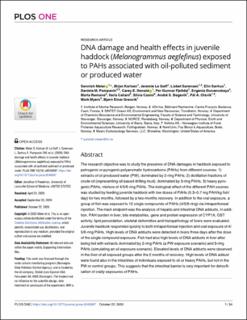| dc.contributor.author | Meier, Sonnich | |
| dc.contributor.author | Karlsen, Ørjan | |
| dc.contributor.author | Le Goff, Jérémie | |
| dc.contributor.author | Sørensen, Lisbet | |
| dc.contributor.author | Sørhus, Elin | |
| dc.contributor.author | Pampanin, Daniela Maria | |
| dc.contributor.author | Donald, Carey E. | |
| dc.contributor.author | Fjelldal, Per Gunnar | |
| dc.contributor.author | Dunaevskaya, Evgenia | |
| dc.contributor.author | Romano, Marta | |
| dc.contributor.author | Caliani, Ilaria | |
| dc.contributor.author | Casini, Silvia | |
| dc.contributor.author | Bogevik, Andre S. | |
| dc.contributor.author | Olsvik, Pål Asgeir | |
| dc.contributor.author | Myers, Mark | |
| dc.contributor.author | Grøsvik, Bjørn Einar | |
| dc.date.accessioned | 2021-02-16T14:15:48Z | |
| dc.date.available | 2021-02-16T14:15:48Z | |
| dc.date.created | 2020-11-25T11:17:58Z | |
| dc.date.issued | 2020 | |
| dc.identifier.citation | Meier, S., Karlsen, Ø., Le Goff, J., Sørensen, L., Sørhus, E., Pampanin, D. M. ... Grøsvik, B. E. (2020). DNA damage and health effects in juvenile haddock (Melanogrammus aeglefinus) exposed to PAHs associated with oil-polluted sediment or produced water. PLoS ONE, 15(10). doi: | en_US |
| dc.identifier.issn | 1932-6203 | |
| dc.identifier.uri | https://hdl.handle.net/11250/2728470 | |
| dc.description.abstract | The research objective was to study the presence of DNA damages in haddock exposed to petrogenic or pyrogenic polyaromatic hydrocarbons (PAHs) from different sources: 1) extracts of oil produced water (PW), dominated by 2-ring PAHs; 2) distillation fractions of crude oil (representing oil-based drilling mud), dominated by 3-ring PAHs; 3) heavy pyrogenic PAHs, mixture of 4/5/6-ring PAHs. The biological effect of the different PAH sources was studied by feeding juvenile haddock with low doses of PAHs (0.3–0.7 mg PAH/kg fish/day) for two months, followed by a two-months recovery. In addition to the oral exposure, a group of fish was exposed to 12 single compounds of PAHs (4/5/6-ring) via intraperitoneal injection. The main endpoint was the analysis of hepatic and intestinal DNA adducts. In addition, PAH burden in liver, bile metabolites, gene and protein expression of CYP1A, GST activity, lipid peroxidation, skeletal deformities and histopathology of livers were evaluated. Juvenile haddock responded quickly to both intraperitoneal injection and oral exposure of 4/5/6-ring PAHs. High levels of DNA adducts were detected in livers three days after the dose of the single compound exposure. Fish had also high levels of DNA adducts in liver after being fed with extracts dominated by 2-ring PAHs (a PW exposure scenario) and 3-ring PAHs (simulating an oil exposure scenario). Elevated levels of DNA adducts were observed in the liver of all exposed groups after the 2 months of recovery. High levels of DNA adduct were found also in the intestines of individuals exposed to oil or heavy PAHs, but not in the PW or control groups. This suggests that the intestinal barrier is very important for detoxification of orally exposures of PAHs. | en_US |
| dc.language.iso | eng | en_US |
| dc.publisher | PLOS | en_US |
| dc.rights | Navngivelse 4.0 Internasjonal | * |
| dc.rights.uri | http://creativecommons.org/licenses/by/4.0/deed.no | * |
| dc.title | DNA damage and health effects in juvenile haddock (Melanogrammus aeglefinus) exposed to PAHs associated with oil-polluted sediment or produced water | en_US |
| dc.type | Peer reviewed | en_US |
| dc.type | Journal article | en_US |
| dc.description.version | publishedVersion | en_US |
| dc.rights.holder | © 2020 The Author(s) | en_US |
| dc.subject.nsi | VDP::Landbruks- og Fiskerifag: 900::Fiskerifag: 920 | en_US |
| dc.subject.nsi | VDP::Matematikk og Naturvitenskap: 400::Zoologiske og botaniske fag: 480::Økotoksikologi: 489 | en_US |
| dc.source.pagenumber | 34 | en_US |
| dc.source.volume | 15 | en_US |
| dc.source.journal | PLOS ONE | en_US |
| dc.source.issue | 10 | en_US |
| dc.identifier.doi | 10.1371/journal.pone.0240307 | |
| dc.identifier.cristin | 1852126 | |

